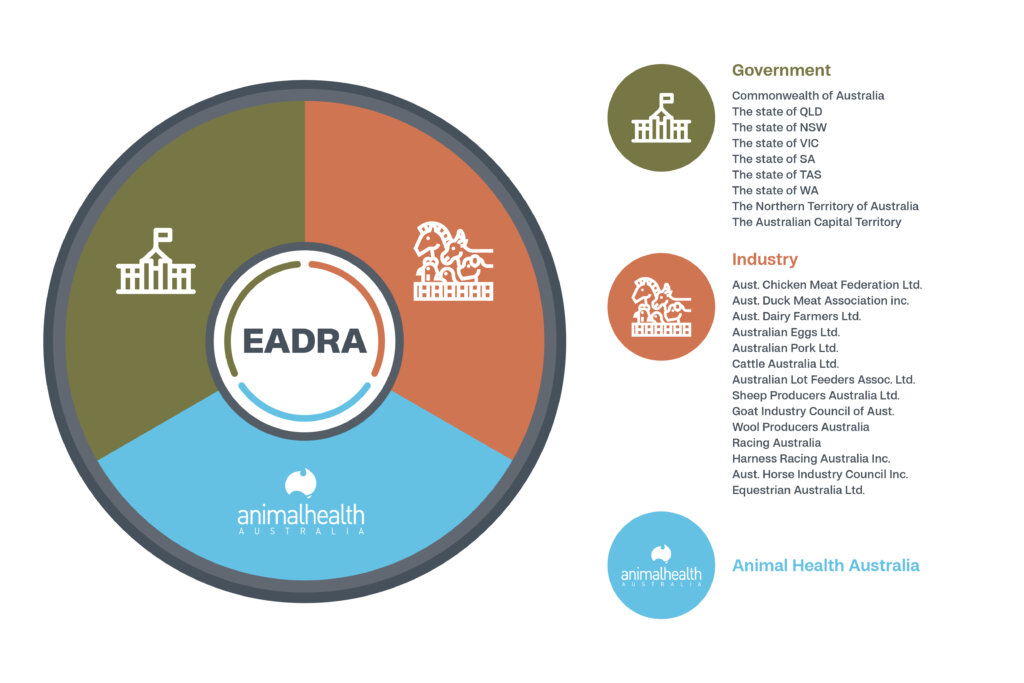The Emergency Animal Disease Response Agreement (EADRA) relies on the active participation of all signatories to manage biosecurity risks and ensure a rapid, coordinated, and effective response to emergency animal disease (EAD) outbreaks.
In addition to these responsibilities, signatories (including AHA) are obliged to be prepared and ready for an emergency animal disease response. See Normal Commitments for details.
EADRA signatories

Signatory roles and responsibilities
Animal Health Australia (AHA)
- manages the EADRA on behalf of all signatories
- coordinates workshops and updates to the EADRA
- facilitates communication and decision-making during responses
- administers cost-sharing arrangements and maintains supporting documents
- convenes meetings and working groups of relevant parties when required
- develops and delivers training for potential Liaison Livestock Industry representatives and members and advisors of the Consultative Committee on Emergency Animal Disease and National Management Group (for details, see Increasing Member Response Capability)
Australian Government
- provides national coordination
- chairs the national committees that determine how the response is managed
- participates in cost-sharing of eligible response activities and underwrites the industry share of eligible response costs
- supports international trade and biosecurity policy alignment
State and territory governments
- lead the on-ground response to EAD outbreaks within their jurisdictions
- administer compensation payments under local legislation
- maintain surveillance and diagnostic capabilities
- implement and enforces legal orders for movement and other biosecurity controls
- collaborate with industry and other jurisdictions during responses
- funds response activities within the state or territory and submits claims for cost sharing
- participates in the cost-sharing of eligible response activities undertaken in other jurisdictions
Industry signatories
- represent livestock sectors affected by listed EADs
- participate in decision-making through empowered representatives
- share in the costs of eligible response activities
- support preparedness, training, and communication within their sectors
- nominate personnel for response roles (e.g. LLIs, CCEAD and NMG representatives)
Local control centres
- coordinate operational aspects of the response at the local level
- manage compensation claims and valuation processes
- serve as the primary point of contact for affected producers
- implement movement control, biosecurity, surveillance, and animal welfare measures
Veterinarians and producers
- play a frontline role in early detection and reporting of EADs
- comply with response measures and biosecurity protocols
- work with authorities to support containment, eradication and recovery
Contacts and communications
AHA maintains a list of contacts for all Parties of the EADRA. Formal communications relating to EADRA activities and processes are circulated via these contacts. The role and responsibilities of each contact type is listed below.
| Contact type | Role and responsibilities |
|---|---|
| Signatory |
|
| Authorised Signatory |
|
| Contact Officer for Notices |
|
| Technical Contacts |
|
Industry and government biosecurity plans
Clause 14 of the EADRA sets out the shared responsibility of all signatories to maintain coordinated biosecurity measures that help prevent emergency animal disease outbreaks. Part of these measures is the development and implementation of industry biosecurity plans and government biosecurity statements and strategies.
Industry biosecurity plans — documents developed by livestock sectors to guide disease prevention, early detection, and response readiness across producers and supply chains. For more information, see Better On-farm Biosecurity.
Government biosecurity strategies — strategic frameworks developed and maintained by federal, state, and territory governments that outline biosecurity policies and programs relevant to their responsibilities. For details, see Government biosecurity statements and strategies.
Together, these plans are a vital part of Australia’s biosecurity system.